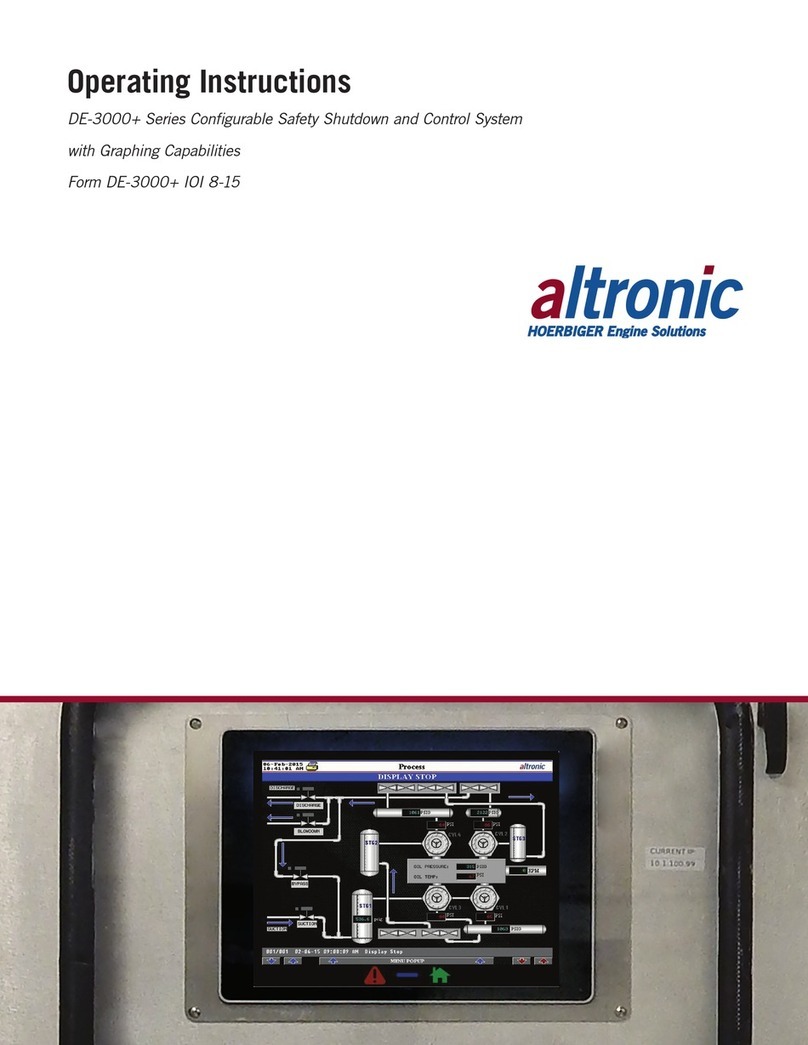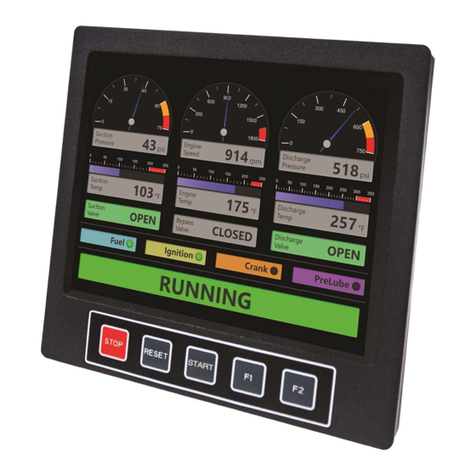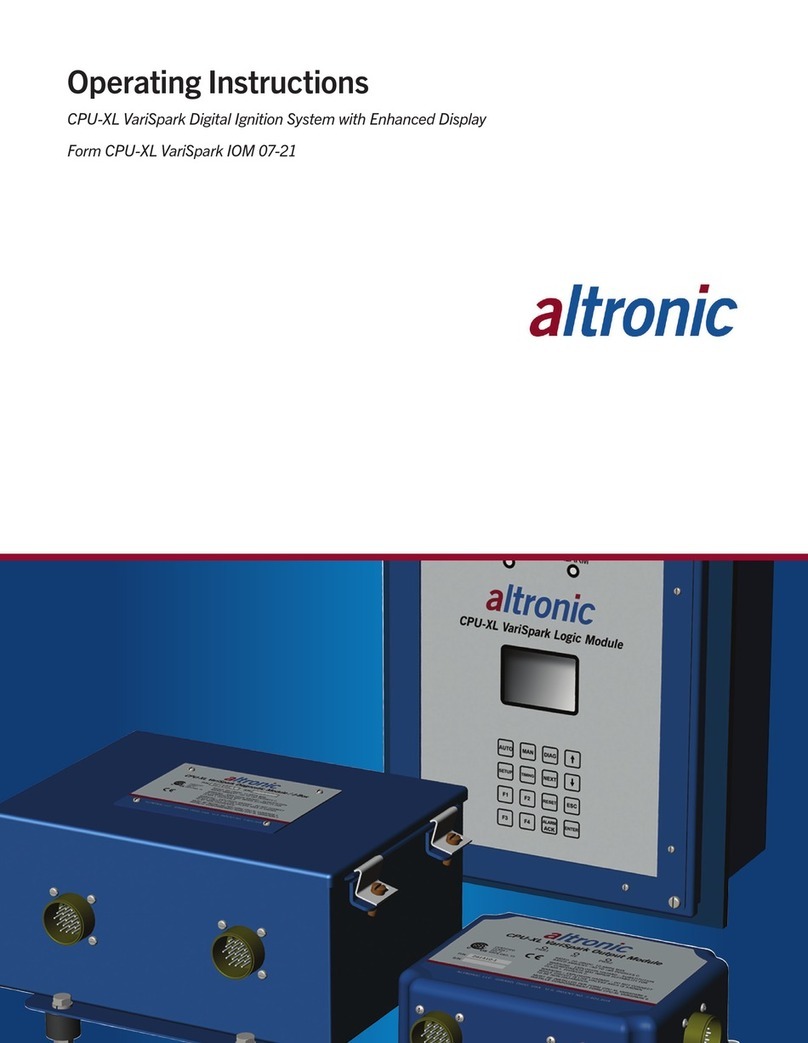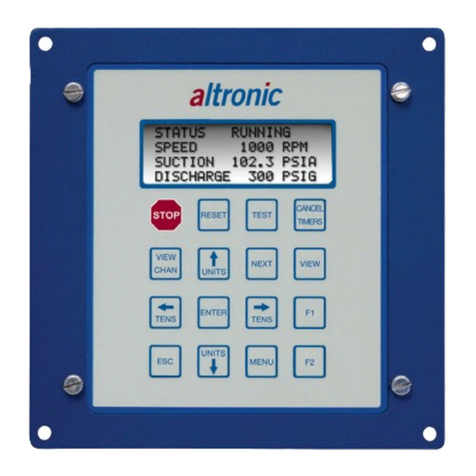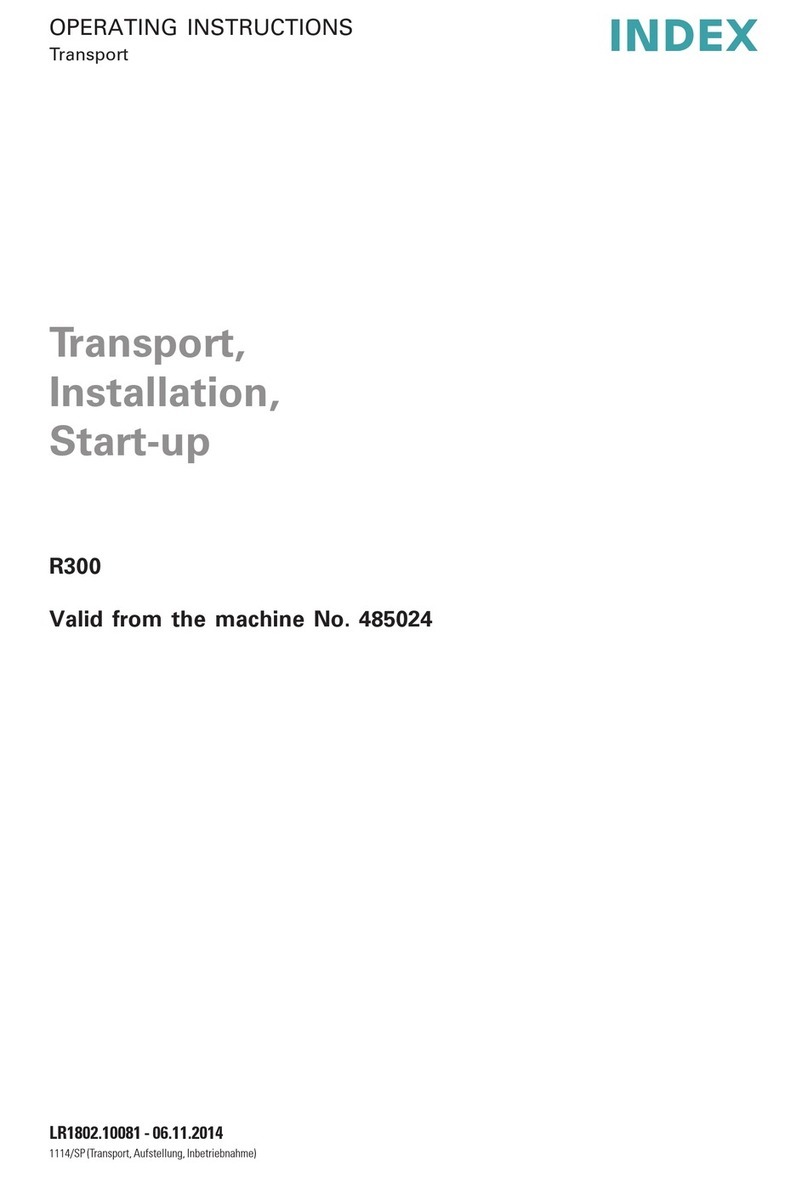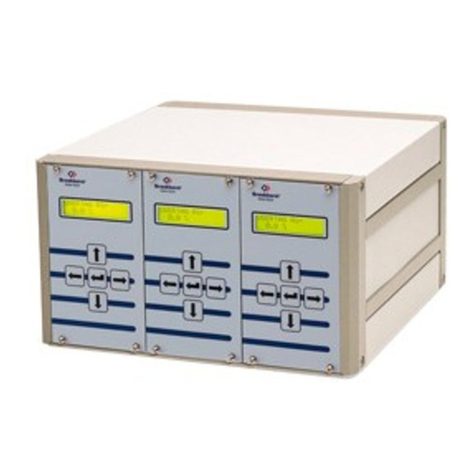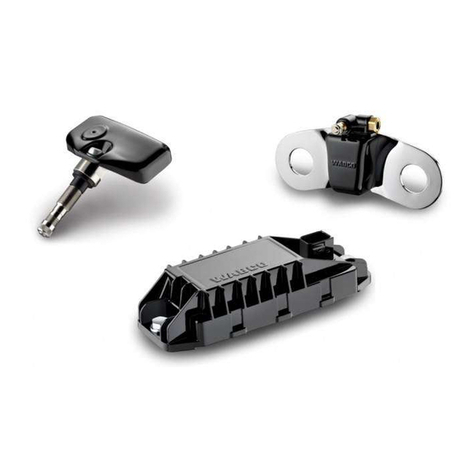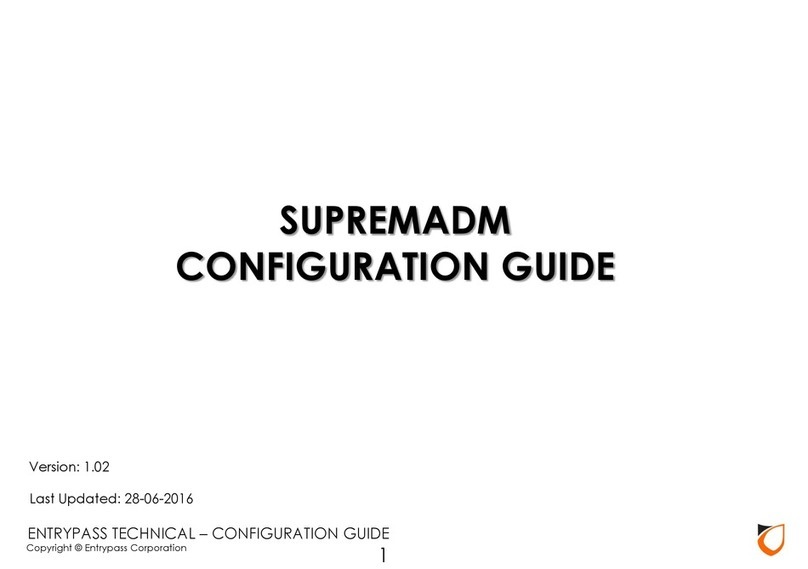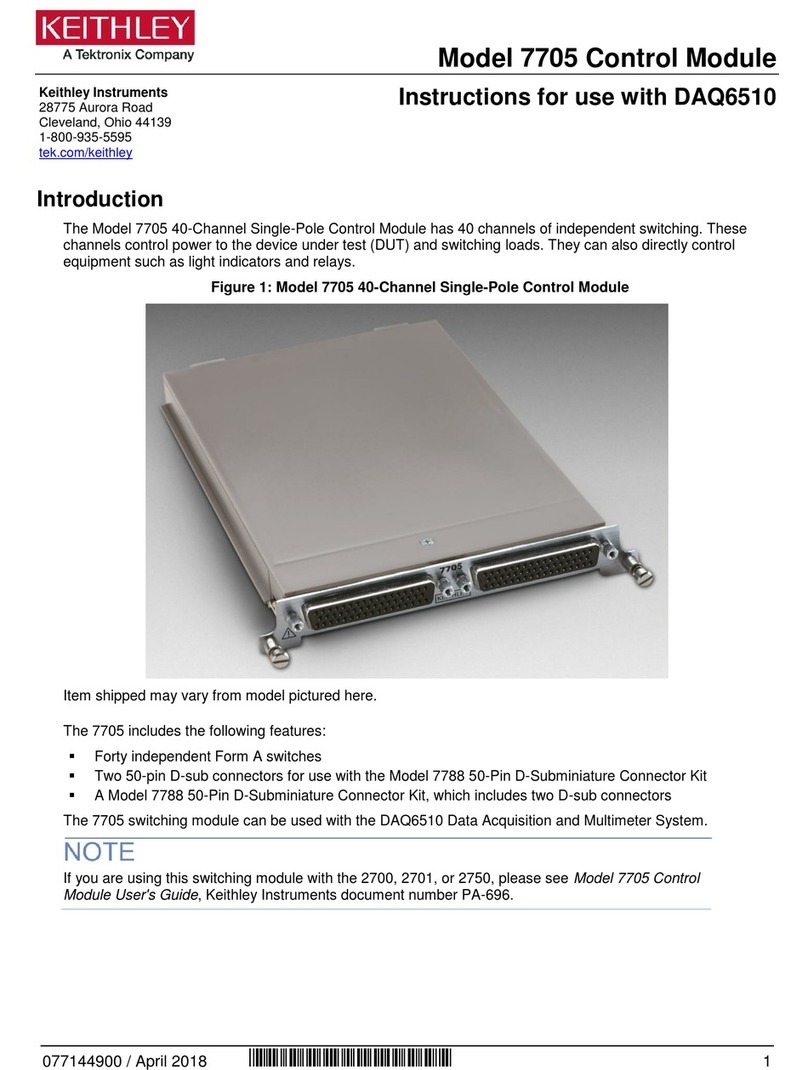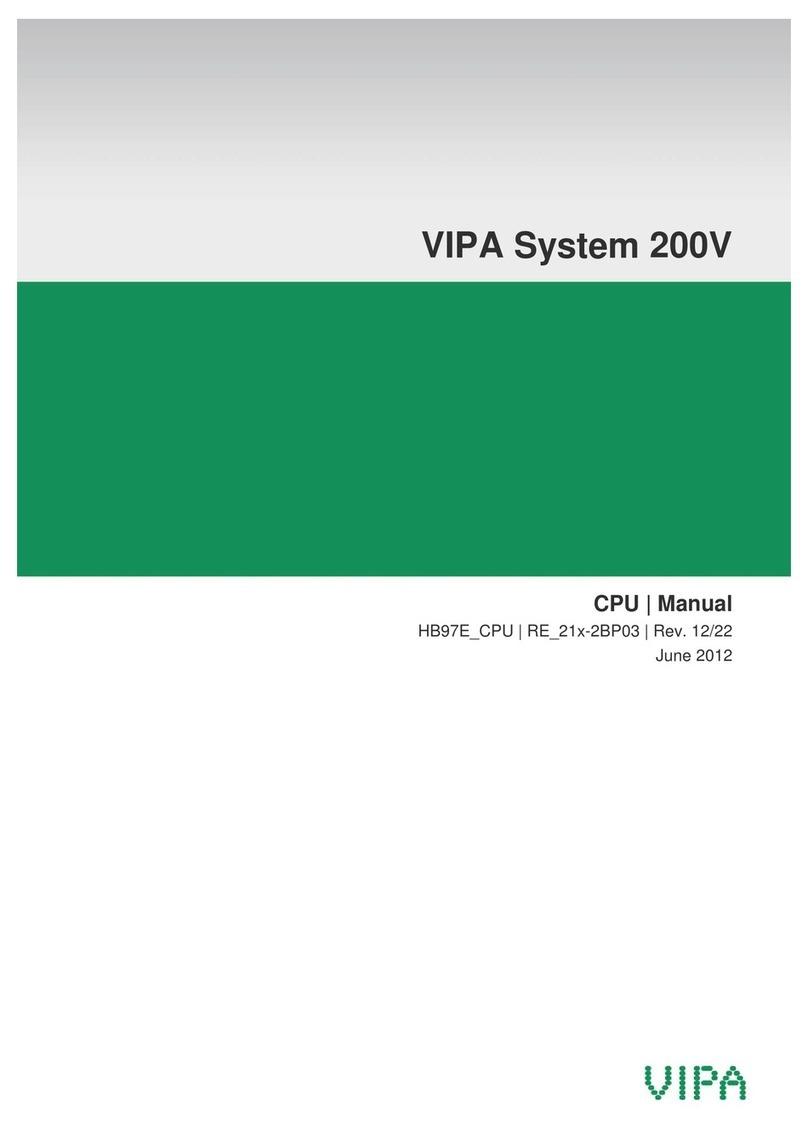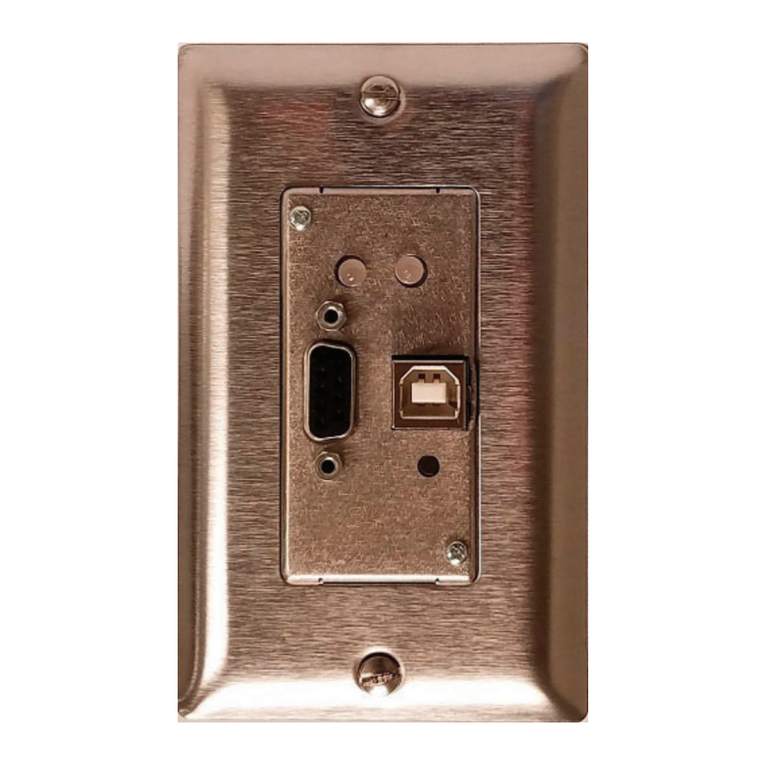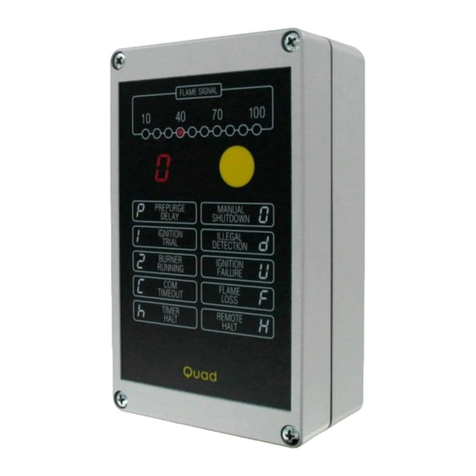Altronic DD-40NTV-O User manual

INSTALLATION INSTRUCTIONS
DIGITAL ANNUNCIATOR
DD-40NTV-O, DD-40NTV-U
DEVIATION FROM THESE INSTRUCTIONS MAY LEAD TO IMPROPER OP-
ERATION OF THE MACHINE WHICH COULD CAUSE PERSONAL INJURY
TO OPERATORS OR OTHER NEARBY PERSONNEL.
WARNING:
www.altronicinc.com
FORM DD-40NTV II 12-09
www.altronicinc.com 1
1.0 OVERVIEW
1.1 The Altronic DD-40NTV digital annunciator is an electronic, 40-
point monitor and shutdown device. The annunciator has a built-
in hourmeter/tachometer, overspeed and underspeed*protection,
and pre-/post-lube control*. Local display and remote communi-
cation (via ModBus RTU) is included for all critical operating pa-
rameters, including the internal battery, supplied DC power, and
CD ignition shutdown lead voltages.
1.2 The DD-40NTV annunciator is suitable for use in Class I, Division 2,
Group C or D hazardous areas and consists of the following items:
•DD-40NTV-O
Annunciator, 40 normally-open points
•DD-40NTV-U
Annunciator, 40 normally-closed or open
points (can be mixed)
•691200-3 Power Supply: 10–30 Vdc, 50 mA max.
or 100–400 volt negative ground CD ignition systems
•693115-1 Cable, DB-25 (2 required for DD-40NTV-U
unit only)
•693116-1 Cable, D:B-9 (for RS-232 serial communications)
1.3 RS-232/RS-485 serial communications are provided for
remote engine monitoring via modem or satellite. Serial
communications require the use of the DC power option.
1.4 For reliable operation, the following instructions must be
adhered to strictly.
DEVIATION FROM THESE INSTRUCTIONS MAY LEAD TO
IMPROPER OPERATION OF THE MACHINE WHICH COULD
CAUSE PERSONAL INJURY TO OPERATORS OR OTHER
NEARBY PERSONNEL.
WARNING:
NOTE: The DD-40NTV annun-
ciator may also be used with
the 691200-1 Power Supply
to emulate the function of
the DD-40NTS system. For
more detail, refer to Form
DD-40NTS II 5-02.
Features designated by an * in these Installation Instructions
are NOT available if using the 691200-1 Power Supply.

FORM DD-40NTV II 12-09
2
DD-40NTV DIGITAL ANNUNCIATOR
NOTE: If possible, keep the
original shipping container.
If future transportation or
storage of the annunciator
is necessary, this container
will provide the optimum
protection.
2.0 MOUNTING
2.1 ANNUNCIATOR UNIT:
Using four #10 screws, mount the Annunciator Unit inside a control
panel or to a suitable at surface so that the display is at a conve-
nient viewing height. A drilling template is provided. The annun-
ciator unit box must be grounded.
2.2 691200-3 POWER SUPPLY:
The Power Supply mounts directly to the back of the Annunciator
Unit using two 8-32 x 5/16" length screws provided.
3.0 WIRING (FIGS. 7 – 20)
3.1 The annunciator unit plugs into the power supply through a DB-9
connector.
3.2 The sensor leads connect to the removable terminal strips on the
back of the annunciator. These terminal strips match those used
with the earlier DD-40NT/DD-20NT systems.
3.3 At the terminal strip of the Annunciator unit, strip the insulation
back 3/8"; twist the exposed wires tightly together. Insert the ex-
posed wire end completely into the terminal strip and securely
tighten the clamping screw. It is suggested that wire 18 AWG (max.)
to 24 AWG (min.) be used for the connections directly to the an-
nunciator terminal strip connector.
3.4 Wires running to the various sensors should be in good condition
or replaced with new wiring. Terminations to the main panel ter-
minal strip (if used) should be made with a suitable terminal and
crimping tool or by soldering. There is no requirement for explo-
sion-proof conduit or Class I enclosures; however, suitable physical
protection should be provided.
NOTE: Avoid mounting with
the LCD display facing direct
sunlight.
The display temperature
range is -40°F. to +175°F.
WARNING: REGARDING OLDER ALTRONIC OVERSPEED DEVICES
IF RETROFITTING INTO AN OLDER PANEL, THE DD-40NTV ANNUNCIATOR WILL NOT
RECOGNIZE THE OUTPUT SIGNAL FROM OLDER ALTRONIC OVERSPEED DEVICES:
DTO-1000, DTO-1010, DTO-2200, DTO-3200
DTHO-2100, DO-3300, PTO-2100, PTHO-2100
THESE DEVICES WILL NOT WORK FOR OVERSPEED PROTECTION IN CONJUNCTION
WITH A DD-40NTV ANNUNCIATOR. FOR SUCH PROTECTION, USE THE OVERSPEED
FEATURE BUILT INTO THE DD-40NTV ANNUNCIATOR (REFER TO SECTION 6.3).

www.altronicinc.com 3
DD-40NTV DIGITAL ANNUNCIATOR
4.0 ANNUNCIATOR CONFIGURATION
4.1 The DD-40NTV series unit MUST be congured prior to use. If re-
placing an older series DD series annunciator, modes 1 and 4 can
be used to directly emulate the older system’s performance. Mode
1 duplicates the operation of the DD-40 series and mode 4 dupli-
cates the DD-20 series units. To congure the unit, press the MENU
key to reach the conguration headings from the normal display
mode. After a selection has been made, press the ENTER key to save
the selection. Press MENU to move to the next step. A flowchart
(REFER TO FIG. 6A or 6B) is provided that shows step-by-step pro-
gression through the annunciator conguration procedure.
CAUTION:
A. SENSOR WIRING: SENSOR WIRES WITHIN THE PANEL ENCLOSURE
MUST BE KEPT AT LEAST TWO (2) INCHES FROM OTHER WIRING. USE A
SEPARATE JUNCTION BOX FOR IGNITION AND FUEL VALVE WIRES. RUN
SENSOR LEADS LEAVING THE PANEL IN A CONDUIT SEPARATE FROM ALL
OTHER WIRING AND KEEP SEPARATE THROUGHOUT THE INSTALLATION.
WIRING TO THE SENSORS MUST HAVE A GRADE OF INSULATION CAPABLE
OF WITHSTANDING AN AC VOLTAGE OF 500 V. RMS. SENSOR LEADS MAY
BE CONNECTED TO ANY PASSIVE DEVICE USING CONTACTS SUCH AS
STANDARD SWITCH GAUGES OR LEVEL SWITCHES. DO NOT CONNECT
SENSOR LEADS TO RELAY CONTACTS OR TO ANY VOLTAGE PRODUCING
ELEMENT.
B. SENSORS WILL BE EXPOSED TO MUCH LOWER VOLTAGES AND CURRENT
THAN WITH THE STANDARD MURPHY TATTLETALE OR SIMILAR TYPE
SYSTEM. IN THE CASE OF A FIELD CONVERSION WHERE SENSORS HAVE
PREVIOUSLY BEEN USED WITH MURPHY TATTLETALES, IT IS RECOM-
MENDED THAT THE SENSORS BE CHECKED FREQUENTLY WHEN THE DD
SYSTEM IS FIRST PUT INTO USE. SENSOR CONTACTS MAY BE BURNED
OR PITTED FROM PAST EXPOSURE TO IGNITION SYSTEM PRIMARY VOLT-
AGE. IT IS ADVISABLE TO REPLACE SUCH SENSORS.
C. IF IT BECOMES NECESSARY TO CHECK SENSOR TO PANEL WIRING WITH
AN OHMMETER OR OTHER CHECKER, FIRST DISCONNECT THE PLUG-IN
TERMINAL STRIPS FROM THE BACK OF THE ANNUNCIATOR UNIT. APPLY-
ING VOLTAGE TO THE ANNUNCIATOR THROUGH THE SENSOR LEADS MAY
DAMAGE THE DEVICE. IN ADDITION, THE AREA SHOULD BE TESTED AS
NON-HAZARDOUS BEFORE SUCH TESTING COMMENCES.

FORM DD-40NTV II 12-09
4
DD-40NTV DIGITAL ANNUNCIATOR
4.2 CONFIGURE MODE:
The mode selection allows the unit to be programmed in one of four
modes as shown. The RESET button must be pressed after a change
in mode number.
MODE TYPE OF POINTS CHANNELS NOTES
1 24 Class A 30-37, 40-47, 50-57 Duplicates operation
16 Class B1 10-17, 20-27 DD-40NT series.
2 24 Class A 30-37, 40-47, 50-57
12 Class B1 10-17, 20-23
4 Class B2 24-27
3 24 Class A 30-37, 40-47, 50-57
10 Class B1 10-17, 20-21
2 Class B2 22-23
4 Class C 24-27
4 12 Class A 20-27, 30-32, 40 Duplicates operation
8 Class B1 10-17 of DD-20NT series.
Class Denitions:
Class A Point is always armed.
Class B1 Point is armed B1 time after power-up or pressing the
RESET key.
Class B2 Point is armed B2 time after power-up or pressing the
RESET key.
Class C Point is armed after it clears.
Use the UP and DOWN keys to select the mode and press the ENTER
key to save the mode.
4.3 PROGRAM RPM 1:
This selects the RPM pre-divide number equal to the pulses per
revolution (PPR). The RPM signal can be from either a CD ignition
shutdown lead or a magnetic pickup. The range is selectable from 0
to 361 PPR. A “0” PPR VALUE is used in applications where a speed
input is not used. Use the UP and DOWN keys to select the proper pre-
divide number and press the ENTER key to save.
4.4 PROGRAM RPM 2:
This selects the RPM overspeed value. The range is selectable from
1 to 2499 RPM. Use the UP and DOWN keys to select the overspeed
value and press the ENTER key to save the selection. To disable the
NOTE: A keypad sequence
(password) is required to
edit values. From the sta-
tus screen press and hold
the ENTER key, then press
the MENU key allow values
to be modied. Otherwise,
selected items may only be
viewed. There is no similar
protection for the TIMER
button (Class B1 and B2
timers) or hourmeter.

www.altronicinc.com 5
DD-40NTV DIGITAL ANNUNCIATOR
overspeed function, enter 2500.
4.5 PROGRAM RPM 12*:
This selects the RPM underspeed value. The range is selectable from
0 to 2500 RPM. Use the UP and DOWN keys to select the underspeed
value and press the ENTER key to save the selection. To disable the
underspeed function, enter 2500.
4.6 PROGRAM PRE-LUBE P1*:
This selects the time delay in seconds for which the LUBE (LUB) out-
put is actuated on start-up. The range is from 1 to 999 seconds. Use
the UP and DOWN keys to select the desired pre-lube time (in sec-
onds) and press the ENTER key to save the selection. Entering a value
of zero (0) as the setpoint disables the pre-lube function.
4.7 PROGRAM POST-LUBE P2*:
This selects the time delay in seconds for which the LUBE (LUB)
output is actuated following a manual STOP or SHUTDOWN. The
range is from 1 to 999 seconds. Use the UP and DOWN keys to select
the desired post-lube time (in seconds) and press the ENTER key to
save the selection. Entering a value of zero (0) as the setpoint dis-
ables the post-lube function.
4.8 PROGRAM TIMER 2:
This selects the time delay in seconds for tripping SDI and OUTPUT
2 after a fault occurs. The range of the delay is from 1 to 60 seconds.
Use the UP and DOWN keys to select the time and press the ENTER key
to save the selection. In typical applications, SW1 is used to turn off
the fuel and either SDI or SW2 is used to turn off the ignition.
4.9 PROGRAM SW1:
This selects the RUN state of output SW1, normally open (N.O.) or
normally closed (N.C.). Use the UP and DOWN keys to select the state
and press ENTER to save.
4.10
PROGRAM SW2:
This selects the RUN state of output SW2, normally open (N.O.) or
normally closed (N.C.). Use the UP and DOWN keys to select the state
and press ENTER to save.
4.11
PROGRAM SERIAL MODE:
This selects the type of communications used by the annunciator.
Selections are provided for NONE (must be used for ignition pow-
ered applications), RS-232 ASCII (A 232), RS-232 Modbus RTU
(232), RS-485 ASCII (A 485), or RS-485 Modbus RTU (485). Use
the UP and DOWN keys to select the state and press ENTER to save.
4.12
PROGRAM BAUD RATE*:
This selects the baud rate for communications. Select either 9600 or
38.4k baud. Use the UP and DOWN keys to select the baud rate and press
the ENTER key to save the selection. This applies only for serial commu-
nications and need not be programmed for non-serial applications.

FORM DD-40NTV II 12-09
6
DD-40NTV DIGITAL ANNUNCIATOR
4.13
PROGRAM NODE NUMBER:
This selects the node number for the annunciator. The range of the
node number is from 01 to 99. Use the UP and DOWN keys to select the
node number and press the ENTER key to save the selection. This ap-
plies only for serial communications and need not be programmed
for non-serial applications.
4.14
PROGRAM HOURS:
This selects the pre-programmed number of hours. The range is
from 00000 to 99999 hours. Press the UP and DOWN arrow keys to
modify the hours, then press the ENTER key to save.
4.15
PROGRAM TYPE:
This selects the type of Power Supply being used with the system;
type.1 for 691200-1 (NTS mode) or type.3 for 691200-3 (NTV mode).
4.16
TIMER KEY:
This selects the B1 and B2 timer delays. The range is from 1 to 999
seconds. Pressing the TIMER key once displays the B1 timer, and
pressing the TIMER key again displays the B2 timer. Use the UP and
DOWN keys to change the respective B timer and press the ENTER key
to save the selection.
4.17
DEFAULT SETTINGS:
As shipped from the factory, the device default settings are as follows:
MODE 1
RPM1 (PPR) 1
RPM2 200 RPM
RPM 12 2500 RPM
P1*0
P2*0
TIMER2 5 seconds
SW1 N.O.
SW2 N.O.
SERIAL MODE None
BAUD RATE*9600
NODE NUMBER 01
HOURS 00000
B1 TIMER 5 seconds
B2 TIMER 10 seconds
TYPE 3
NOTE: Unit must be properly
congured for each applica-
tion prior to use.

www.altronicinc.com 7
DD-40NTV DIGITAL ANNUNCIATOR
5.0 KEYPAD DESCRIPTION/FUNCTION
5.1 MENU:
This key allows the user to view/change the following:
•Mode selection
•Pulses per revolution
•Overspeed value
•Underspeed value*
•Pre-lube on-time*
•Post-lube on-time*
•Output switch 1
•Output switch 2
•Communications
•Baud rate*
•Output timer 2
•Node number
•Programmed hours
•Power Supply Type
5.2 UP ARROW:
This key is used to increment/modify selections and allows the user to
view the current RPM, the hourmeter reading, annunciator status, and
all of the monitored electrical voltages*(back-up battery, external DC
power, and CD ignition power.
5.3 DOWN ARROW:
This key is used to decrement/modify selections and allows the user to
view the current RPM, the hourmeter reading, annunciator status, and
all of the monitored electrical voltages (back-up battery, external DC
power, and CD ignition power.
5.4 ENTER:
This key allows for selected items to be saved. When pre- or post-
lubing, pressing the ENTER key will also cancel lubrication.
5.5 STOP:
This key initiates a shutdown condition and the unit will display a
status of [60]. This has precedence over all other functions.
5.6 RESET:
This key clears any faults and resets the Class B1 and B2 timers. If
the pre-lube function is active, RESET also actuates the LUB output.*
The annunciator displays [00] if one or more points is not armed.
Once all the channels are armed, the display reads [01]. The annun-
ciator will power up in the RESET mode. The unit will not reset the
outputs if any of the Class A points are faulted.
LOOPS TO HOME SCREEN
FROM THE HOME SCREEN
BATTERY VOLTAGE*
EXTERNAL DC POWER VOLTAGE*
CD IGNITION SHUTDOWN LEAD VOLTAGE*
PRESS
I: 1 8 6.2
2 4.3
8:
3.6
6:
01
PRESS
PRESS
PRESS
PRESS
00056
100 3
PRESS
RPM
HOURS

FORM DD-40NTV II 12-09
8
DD-40NTV DIGITAL ANNUNCIATOR
5.7 TEST:
This key provides for battery and operating voltage tests and also
allows inputs to be tested (faulted) without causing a shutdown. The
battery in the Power Supply may be checked when the machine is
down and the display reads [00]; push and hold the TEST key – a read-
ing of [80] indicates satisfactory battery voltage. The operating volt-
age may be checked when the machine is operating and the display
reads [01]; push and hold the TEST key – a reading of [89] indicates
the operating voltage is acceptable. To test the sensor input points,
the annunciator must rst be displaying [01] meaning all points are
armed. Push and release the TEST key, and the display will read [09]
indicating the Test Mode. Faulted points will be displayed but will
not cause the outputs to trip. Testing an additional point requires
the TEST key to be pressed again. The annunciator will remain in test
mode for two minutes before reverting back to the running mode
[01]. Any point not cleared in two minutes (either by pressing the TEST
or RESET key) will cause the outputs to trip.
5.8 TIMER:
This key allows the B1 and B2 delay timers to be viewed or modied.
5.9 KEYPAD SEQUENCE (PASSWORD) PROTECTION:
From the status screen, press and hold the ENTER key, then press the
MENU key to allow values to be modied. Otherwise, the selected
items may only be viewed. There is no keypad sequence protection
for the TIMER key (Class B1 and B2 timers).
5.10
CANCEL TIMERS:
From the status screen, depress the ENTER key. While holding the ENTER
key, also press the DOWN ARROW key.
6.0 OPERATION
See chart on next page.
NOTE: Two fault occurrences
will override the TEST mode:
manual STOP function [60]
and OVERSPEED [70].

www.altronicinc.com 9
DD-40NTV DIGITAL ANNUNCIATOR
NOTE:
a.) TEST cannot be used
until the start-up timer
interval ends – [01] on
the display.
b.) A display reading of [09]
means the system output
will not activate unless the
STOP button is pushed.
c.) Do not leave a sensor
number on the display
after the last test; push
the TEST button to get
[09] on the display; then
wait two minutes until
[01] displays or select
the CANCEL TIMERS
feature.
d.) For a complete system
test, allow the test timer
interval to expire – display
changes from [09] to [01]
– then cause one sensor
to fault and allow the sys-
tem output to activate.
This will test the entire sys-
tem for correct operation
upon a fault with minimal
downtime.
6.1 OPERATING SEQUENCE
MACHINE DISPLAY FUNCTION DESCRIPTION
Down [10-57] Shutdown
Shutdown caused by the fault number
indicated. Number will remain until fault
is corrected and RESET button depressed.
[60]
Shutdown
Shutdown caused by depressing STOP button.
[70]
Shutdown Shutdown caused by overspeed.
[71] Shutdown Shutdown caused by loss of RPM signal.
[72]*Shutdown Shutdown caused by underspeed. This is
a Class C function which is armed when
the setpoint is exceeded by 100 RPM.
[80] Shutdown Push TEST button when down, indicates
battery is OK.
[00] Reset
Before starting machine, momentarily push
the RESET button. A display of [00] indicates
all Class A sensors are ready for start-up.
Any number 10-57 indcates a faulted sensor
that must be cleared before start-up.
[60]
Engine Purge
To purge engine prior to start, depress
the STOP button, roll the engine to
purge, then push the RESET button.
Engine can then be started provided
display reads [00].
[61]
Shutdown
Shutdown caused by DE, a serial stop
command.
Running [00] Start-up Start-up timers have Class B1 and B2
points disarmed. All Class A points are
being monitored. Pushing the RESET
button re-cycles the start-up timers. To
cancel the start-up timers, press the
ENTER key, followed by the DOWN key
while still depressing the ENTER key.
[01] Normal
All points are being monitored. The transi-
tion from [00] to [01] indicates the end of
the last start-up timer interval.
[89] Test From [01] display, press and hold TEST
button; indicates adequate operating
voltage.
[09] Test
Press and release TEST button – a timed test
period is initiated for approximately two
minutes. As a sensor is faulted, its number
is latched on the display (but the output is
not activated). To move to the next point,
rstclearthesensor,thenpushtheTEST
button again. The display reverts to [09] until
the next sensor is faulted. After the last test,
push the TEST button to get [09] on the
display; wait two minutes until [01] displays.
[01] Normal
Test period has ended; all points are being
monitored. DO NOT LEAVE MACHINE UN-
LESS DISPLAY READS [01].

FORM DD-40NTV II 12-09
10
DD-40NTV DIGITAL ANNUNCIATOR
6.2 RPM/HOURMETER:
Press the UP and DOWN keys to view the RPM, hourmeter and volt-
ages*. The RPM screen remains until the operator chooses another
option. The HOURS display will revert to the status screen after two
minutes. In either case, the annunciator will display the fault num-
ber when a shutdown occurs.
6.3 RPM OVERSPEED PROTECTION:
The DD-40NTV annunciator has a built in tachometer to monitor
engine overspeed. When the detected RPM is greater than the RPM
overspeed setpoint, the annunciator will trip the fuel and ignition
outputs. When this occurs, the unit will display [70] and activate
the FAULT indicator. REFER TO FIGS. 7 — 20 for the further details.
6.4 RPM UNDERSPEED PROTECTION*:
The DD-40NTV annunciator has a built in tachometer to monitor
engine underspeed. This point is armed when the underspeed set-
point is exceeded by 100 RPM. Once armed, should the monitored
RPM fall below the setpoint, the annunciator will trip the fuel and
ignition outputs. When this occurs, the unit will display [72] and
activate the FAULT indicator. REFER TO FIGS. 7 — 20 for further details.
6.5 BATTERY:
The Power Supply contains a special long-life lithium battery. When
the monitored equipment is not operating, current draw from the
battery is only microamps (millionths of amps). When the annun-
ciator is powered, there is no drain from the battery. This allows for
a battery life of up to 5 years in normal operation. The battery in the
power supply is replaceable; use ONLY Altronic part no. 601952.
Be sure to observe the proper polarity as marked in the Power Sup-
ply when replacing the battery.
THE DD-40NTV ANNUNCIATOR WILL NOT RECOGNIZE THE
OUTPUT SIGNAL FROM AN ALTRONIC DTO-3200 OR OTHER
OLDER OVERSPEED DEVICES (SEE LISTING ON PAGE 2).
THESE DEVICES WILL NOT WORK FOR OVERSPEED PROTEC-
TION IN CONJUNCTION WITH A DD-40NTV ANNUNCIATOR.
FOR SUCH PROTECTION, USE THE OVERSPEED FEATURE
BUILT INTO THE DD-40NTV ANNUNCIATOR.
WARNING:

www.altronicinc.com 11
DD-40NTV DIGITAL ANNUNCIATOR
7.0 FAULT OUTPUTS
7.1 Two digital outputs, SW1 and SW2 are in the Power Supply. These are
rated 400 volts DC, 0.5 amp maximum.
7.2 Output SW1 will trip immediately upon a fault condition or if the
STOP key is depressed.
7.3 Outputs SDI and SW2 will trip after a pre-programmed time delay
(TIMER PROGM2) from either a fault condition or if the STOP key is
depressed.
7.4 For Power Supplies 691200-1 and 691200-3, the maximum voltage
is 400 volts from a negative ground C.D. ignition with a current
drain of microamps. The maximum current rating is 50 mA when
powered from a DC voltage source of 10 to 30 volts.

FORM DD-40NTV II 12-09
12
DD-40NTV DIGITAL ANNUNCIATOR
8.0 PRE-LUBE/POST-LUBE OUTPUT*
8.1 One (1) digital output LUB is located in the power supply 691200-3*.
It is rated 400 volts DC, 0.5 amp maximum.
8.2 Output LUB will be actuated under two operating conditions:
•Following a RESET (remote or manual), the LUB output will remain actuated
until the pre-lube timer (P1) expires.
•Following a manual STOP or FAULT, the LUB output will remain actuated
until the post-lube timer (P2) expires.
9.0 SERIAL COMMUNICATIONS
9.1 Serial communications may be selected as RS-232 or RS-485 using
ASCII or Modbus RTU protocol.
9.2 MASTER/SLAVE OPERATION:
The RS-485 communication system in the annunciator is designed
as a master/slave system; that is, each unit responds to its own
unique address (node number) only after it is interrogated by the
master (computer). A simple command/response protocol must be
strictly observed.
9.3 NODE NUMBER:
The node number is used in the system to identify the desired slave
unit being polled. The node number can be any numeric value from
1 to 99.
9.4 ASCII COMMUNICATION:
All communication to and from the annunciator is performed using
ASCII characters. This allows the information to be processed with
the “string” functions common to high level computer languages
such as BASIC and C. For computers that support standard serial
port interfaces, no special machine language software drivers are
required. The use of the ASCII format also allows for the connec-
tion of these devices to an auto answer modem for long distance
operation without the need for a local supervisory computer. The
ASCII characters also make system debugging easy using standard
terminal emulation software.
9.5 COMMUNICATIONS PARAMETERS:
•Baud Rate: 9600 or 38.4k*
•Data Bits: 8
•Stop Bits: 1
•Parity: None
NOTE: The letter “L” will ap-
pear in the display when the
LUB output has been actu-
ated. To cancel the pre-lube
or post-lube countdown tim-
ers, press the ENTER key. If
pre-lubing, the annunciator
will immediately initiate the
Class B timer(s).

www.altronicinc.com 13
DD-40NTV DIGITAL ANNUNCIATOR
9.6 COMMAND STRUCTURE:
The annunciator operates with a simple command/response protocol
to monitor all functions. A command must be transmitted to the unit
by the master (computer or PLC) before the slave can respond with use-
ful data. A slave unit can never initiate a communications sequence.
Communication to the annunciator is performed with two character
ASCII command codes. The general format used for the commands is
illustrated below using the READ DATA command as an example. The
hexadecimal values for the characters are shown only as a reference for
those using low level (assembly language) decoding and will not appear
on the communications terminal screen. All of the characters used in
the communications protocol are standard ASCII characters and ap-
pear on the computer keyboard as shown with the exception of the “not
acknowledge” (NAK) which is the industry standard “control U”.
header start node space command end
ASCII > ( 01 R D )
HEX 3Eh 28h 30h 31h 20h 52h 44h 29h
Command Header “>” (3Eh):
Each command must begin with the command header sometimes
referred to as a prompt character. The ASCII character used is the
“>” which means that a command message will be sent from the
master to the slave.
Start of Text “(” (28h):
The command header must be followed by the start of text indicator.
Node Number “01 -99” (30h 31h):
The node number or address of the device being contacted.
Space (20h):
Following the node number is an ASCII space character (not print-
able, value 20h) to act as a delimiter between the node number and
the two character command word.
Command Word “RD” (52h, 44h):
The command words are standard two letter (upper case) com-
mands sent by the master for gathering specic information about
the status of a slave. The commands are listed under STANDARD
COMMANDS below.
End of Text “)” (29h):
The end of text indicator says this is the end of the command.

FORM DD-40NTV II 12-09
14
DD-40NTV DIGITAL ANNUNCIATOR
STANDARD COMMANDS
Information coming from
serial command(s) Command Response Notes
Annunciator status >(01 RD) <(01 XX) (XX - Refer to section 6.0)
Read hourmeter >(01 RH) <(01 XXXXX) (XXXXX = Hours)
Read current RPM >(01 RP) <(01 XXXX) (XXXX = RPM)
Reset the annunciator >(01 RR) <(01 RR)
Stop the annunciator >(01 RS) <(01 RS)
Valid Response:
A command/response sequence is not complete until a valid re-
sponse is received. When a slave unit receives a valid command, it
interprets the command, performs the desired function and then
communicates the response to the master within 20mS. The master
may not initiate a new command until the response from a previous
command is completed.
A valid response can occur in three ways:
•A normal response indicated by a “<” header and “( )” beginning
and end of text.
•An error response indicated by a “§” NAK (not acknowledged).
•A communications time-out error.
An NAK error response will be sent by the annunciator when it has
received a command with an error in the message. All commands
must be of the format above. The header, start-and-end of text char-
acters, a valid node number and spaces must be sent and correct to
receive an NAK; if not, no response will be sent.
9.7 RS-485 COMMUNICATIONS:
•HALF DUPLEX OPERATION:
The RS-485 system employed uses two wires for communica-
tion and cannot send and receive data at the same time over
the same two wires making it a half duplex system. When the
master is in the transmit mode, the slave is in the receive mode
and visa-versa.
•ELECTRICAL OPERATING RANGE:
RS-485 is a communications standard to satisfy the need for
multi-dropped systems that can operate at high speeds over
long distances. RS-485 uses a balanced differential pair of
wires switching from 0 to 5 volts to communicate data. RS-485
drivers can handle common mode voltages from −7 to +12 volts
without loss of data, making them an excellent choice for indus-
trial environments.

www.altronicinc.com 15
DD-40NTV DIGITAL ANNUNCIATOR
•COMMUNICATIONS WIRING:
The RS-485 wiring diagram illustrates the wiring required for
multiple slave unit hookup. Note that every slave unit has a di-
rect connection to the master. This allows any one slave unit
to be removed from service without affecting the operation of
the other units. Every unit must be programmed with a unique
address or node number, but the addition of new units or nodes
can be in any order. To minimize unwanted reections on the
transmission line, the bus should be arranged as a trunk line
going from one module to the next. Random structures of the
transmission line should be avoided. Special care must be taken
with long busses (500 feet or more) to ensure error free opera-
tion. Long busses must be terminated with a 120 ohm resistor
between the terminals marked RS-485 “A” and RS-485 “B” at
the master only. The use of twisted pair shielded cable will en-
hance signal delity and is recommended. To prevent ground
loops the shield should be connected to the shield terminal at
the master only.
•LOADING:
RS-485 uses a balanced differential pair of wires switching
from 0 to 5 volts to communicate data. In situations where
many units (99 max.) are connected together on a long run,
voltage drop on the communications leads becomes a major
problem. Voltage drops on the RS-485 minus lead appear as
a common mode voltage to the receivers. While the receivers
are rated to a maximum voltage difference of ±7 volts, −7V to
+12V, a practical system should not have a voltage difference
exceeding ±3 volts under normal conditions. The wire gauge
used for the connections limits the maximum number of units
or the maximum length of wire between units in each applica-
tion. The following formula can be used as a guideline to select
the appropriate wire gauge.
For 18 AWG wire No. of annunciator units = (4000)/(ft of wire used)
For 20 AWG wire No. of annunciator units = (3600)/(ft of wire used)
For 22 AWG wire No. of annunciator units = (2400)/(ft of wire used)
NOTE: The maximum number
of units that can be connect-
ed in a system is 99.

FORM DD-40NTV II 12-09
16
DD-40NTV DIGITAL ANNUNCIATOR
9.8 RS-232 COMMUNICATIONS:
•For proper operation, the wire length should not exceed 50 feet.
•Use standard DB-9 connector and computer cable Altronic
693 116-x or equivalent.
9.9 MODBUS STRUCTURE:
The annunciator can operate as a Modbus RTU slave. A command must be trans-
mitted to the unit by the master (computer or PLC) before the slave can respond
with useful data. A slave unit can never initiate a communications sequence.
Select the Modbus communications option. SEE SECTION 4.11. Communica-
tion to the annunciator can then be performed using standard Modbus RTU
protocol. Multiple register reads are supported, specify number of registers.
REGISTER MODBUS REGISTER VALUE
40001 RPM (0-2500)
40002 Hourmeter hours (0-65535)
40003 Class B1 timer left to expire (seconds)
40004 Annunciator Status (contains same status as display)
40005 Output Status (bit 0 = SW1, bit 1 = SW2, 1 = tripped, 0 = running)
40006 Input (chan. 10-27; bit 0 = 10, bit 8 = 20, bit 15 = 27)
40007 Input (chan. 30-47; bit 0 = 30, bit 8 = 40, bit 15 = 47)
40008 Input (chan. 50-57; bit 0 = 50, bit 7 = 57, bit 8 = ovrspd,
bit 9 = loss of spd, bit 10 = underspeed)
Input OK = 1, Input Fault = 0; 40006, 40007, 40008
all FF for running OK
40009*Class B2 timer left to expire (seconds)
40010*Test timer left to expire (max. 120 seconds); 0 = not in Test Mode
40011*Time from Fuel Trip (seconds) before Ignition Shutdown
40012*Pre-lube left to expire (seconds); 0 = prelube not being performed
40013*Post-lube left to expire (seconds); 0 = postlube not being performed
40018*Internal Battery Voltage (Example: 36 = 3.6 volts)
40019*DC Power Voltage (Example: 246 = 24.6 volts)
40020*Ignition Voltage (Example: 1847 = 184.7 volts)
40021*B1 Setpoint (seconds)
40022*B2 Setpoint (seconds)
40023*Ignition Delay Setpoint (seconds)
40024*Prelube Setpoint (seconds)
40025*Postlube Setpoint (seconds)
40026*DD-40NTVCongureMode(SEE SECTION 4.2)
40082*Overspeed Setpoint
40083*Underspeed Setpoint

www.altronicinc.com 17
DD-40NTV DIGITAL ANNUNCIATOR
FIG. 1 SPECIFICATIONS AND DIMENSIONS, DD-40NTV-O
MENU
STOP
TEST
ENTER
TIMER
RESET
TEST
TIMER 1 2
RUN
FAULT
MODE
RPM
HOURS
PROGM
6.50
3.50
2.38
.88
6.00
.203 DIA.
(TYP 4)
6.00
6.50
SPECIFICATIONS:
POWER REQUIRED: DC POWERED 12–24 VDC, 5 WATTS TYPICAL OR
CD IGNITION SYSTEM 100 VOLTS MINIMUM.
INPUTS: RPM SIGNAL FROM CD IGNITION OR PICKUP.
40 DISCRETE SWITCH INPUTS NORMALLY OPEN.
4 SELECTABLE OPERATING MODES FOR NUMBER OF
CLASS A, B (TWO TIMERS B1, B2) AND C SENSORS.
MODE A B1 B2 C
1 24 16 0 0
2 24 12 4 0
3 24 10 2 4
4 12 8 0 0
OUTPUTS: 3 DIGITAL OUTPUTS.
AUXILIARY TERMINALS FOR CD IGNITION SHUTDOWN AND
FUEL VALVE TRIP, PROGRAMMABLE DELAY TIME ON OUTPUT SW2.
FEATURES: INTEGRATED UNDERSPEED, OVERSPEED TACHOMETER AND
RUNTIME HOURMETER, PRE-LUBE/POST-LUBE.
DISPLAY CUSTOM 5-DIGIT LCD DISPLAY.
SCAN RATE: SCANS ALL 40 DISCRETE SWITCHES 5 TIMES/SECOND.
OPERATING TEMPERATURE RANGE: – 40° C TO + 80° C (– 40° F TO 176° F)
COMMUNICATIONS: RS–232 OR RS–485, CONNECTION ON POWER SUPPLY
(DC POWER REQUIRED)
HAZARDOUS AREA CLASSIFICATION: CLASS 1, DIV. 2, T4, GROUP C & D.
RS–232
DO NOT CONNECT
IF HAZARDOUS
CONDITION EXISTS
IGN INPUT 100–400V
DC INPUT 10–30VDC
50 mA MAX.
DD–40NTV–O
S/N
CERTIFIED FOR USE IN
CLASS I, DIV. 2, GROUP
C & D AREAS
U.S. Patent 6,738,244
Tx Rx
P/N 691200–3 S/N
GIRARD, OHIO
GIRARD, OHIO
INSTALL PER FORM DD-40NTV II
CERTIFIED CLASS I,
DIV 2, GRP C & D
ANNUNCIATOR POWER SUPPLY
24V
I
G
N
B A
RS485
P
U
R
R
L
U
B
S
W
1
F
V
A
S
W
2
S
D
I
+IG SD S2 FV S1 LB RR PU B A
NOTE: REQUIRES SQUARE
OPENING OF 5.60"

FORM DD-40NTV II 12-09
18
DD-40NTV DIGITAL ANNUNCIATOR
3.50
2.38
.88
4.00
1.85
2.50
6.35
7.00
.50
.190 DIA.
(TYP)
6.00
DB-25 CABLE
P/N 693115
N/O
SWITCH
N/C
SWITCH
UNUSED
OUTPUT
N/O
SWITCH
N/C
SWITCH
UNUSED
OUTPUT
TERMINAL BOARDS
P/N 672169
NON-INCENDIVE
FIELD WIRING ONLY
NON-INCENDIVE
FIELD WIRING ONLY
34 35 36 37 40 41 42 43 44 45 46 47 50 51 52 53 54 55 56 57 C10 11 12 13 14 15 16 17 20 21 22 23 24 25 26 27 30 31 32 33 C
.203 DIA.
(TYP 4)
6.00
RS–232
DO NOT CONNECT
IF HAZARDOUS
CONDITION EXISTS
Tx Rx
P/N 691200–3 S/N
GIRARD, OHIO
INSTALL PER FORM DD-40NTV II
CERTIFIED CLASS I,
DIV 2, GRP C & D
ANNUNCIATOR POWER SUPPLY
24V
I
G
N
B A
RS485
P
U
R
R
L
U
B
S
W
1
F
V
A
S
W
2
S
D
I
+IG SD S2 FV S1 LB RR PU B A
DD–40NTV–U
S/N
GIRARD, OHIO
MENU
STOP
TEST
ENTER
TIMER
RESET
TEST
TIMER1 2
RUN
FAULT
MODE
RPM
HOURS
PROGM
6.50
6.50
SPECI
FICATIONS:
POWER REQUIRED: DC POWERED 12–24 VDC, 5
WATTS TYPICAL OR
CD IGNITION SYSTEM 100 VO
LTS MINIMUM.
INPUTS:
RPM SIGNAL
FROM CD IGNITION OR PICKUP
.
40 DISCRETE SWITCH INPUTS NORMAL
LY OPEN.
4 SELECTABLE OPERATING MODES FOR NUMBER OF
CLASS
A, B (TWO TIMERS B1, B2)
AND C SENSORS.
MODE A B1 B2 C
1 24 16 0 0
2 24 12 4 0
3 24 10 2 4
4 12 8 0 0
OUTPUTS:
2 DIGITAL
OUTPUTS, PROGRAMMABLE, N.O. OR N.C.
AUXILIARY
TERMINALS FOR CD IGNITION SHUTDOWN
AND
FUEL VALVE TRIP, PROGRAMMABLE DELAY TIME ON OUTPUT SW2.
FEA
TURES:
INTEGRAT
ED UNDERSPEED, OVERSPEED T
ACHOMETER AND
RUNTIME HOURMETER, PRE-LUBE/POS
T-LUBE.
DISPLA
Y CUSTOM 5-DIGIT LCD DISPLAY.
SCAN RA
TE: SCANS ALL
40 DISCRETE SWITCHES 5 TIMES/SECOND.
OPER
AT
ING TEMPERA
TURE RANGE: – 40° C TO + 80° C (– 40° F TO 176° F)
COMMUNIC
ATIONS:
RS–232 OR RS–485, CONNECTION ON POWER SUPP
LY
(DC POWER REQUIRED)
HAZARDOUS
AREA CLASSIFICATION: CLASS 1, DIV. 2, T4, GROUP C & D.
U.S. Patent 6,738,
NOTE: REQUIRES SQUARE OPENING OF 5.60"
FIG. 2 SPECIFICATIONS AND DIMENSIONS, DD-40NTV-U

www.altronicinc.com 19
DD-40NTV DIGITAL ANNUNCIATOR
FIG. 3 INSTALLATION DIAGRAM: DD-40NTV-X TO 691200-3 POWER SUPPLY
PIN 1
GIRARD, OHIO
NOTES:
1. PLUG DB–9 CABLE FROM POWER SUPPLY INTO
ANNUNCIATOR UNIT. SECURE WITH SCREWS.
2. SECURE POWER SUPPLY TO ANNUNCIATOR UNIT
WITH 2 EA. B–32 X 5/16" SCREWS PROVIDED.
34 35 36 37 40 41 42 43 44 45 46 47 50 51 52 53 54 55 56 57
10 11 12 13 14 15 16 17 20 21 22 23 24 25 26 27 30 31 32 33

FORM DD-40NTV II 12-09
20
DD-40NTV DIGITAL ANNUNCIATOR
FIG. 4 GENERAL ELECTRICAL HOOK-UP, DD-40NTV-O WITH 691200-3 POWER SUPPLY
IGNITION SHUTDOWN LEAD
SWITCH
IGNITION SHUTDOWN
SWITCH, DC RELAY
SUPPLY FOR CD FUEL VALVE
(BUILT-IN CAPACITOR)
FUEL VALVE SWITCH
(GOES TO GROUND ON FAULT)
PRE-/POST-LUBE OUTPUT*
REMOTE RESET
PICKUP INPUT FOR TACHOMETER
RS485 B COMMUNICATION
RS485 A PORT
CD IGNITION SHUTDOWN
LEAD 100–400 VOLTS
(NEGATIVE GROUND ONLY)
PANEL GROUND
+12–24 VDC
NOTES:
1. ENGINE GROUND AND
PANEL GROUND MUST
BE THE SAME.
2. FOR IGNITION POWER,
USE (IGN) AND ( )
TERMINALS. FOR DC
POWER, USE (+24)
AND ( ) TERMINALS.
3. POWER SUPPLY MINUS
AND SENSOR GROUND
MUST BE AT GROUND.
SERIAL
COMMUNICATION
INDICATORS
RS–232
COMMUNICATION
PORT
NORMALLY OPEN
SENSORS
WARNING:
SENSOR LEADS FROM THE
ANNUNCIATOR MUST NOT
CONTACT ANY EXTERNAL
VOLTAGE SOURCE. DAMAGE
TO THE SYSTEM WILL RESULT
FROM CONNECTION BETWEEN
THE SENSOR LEADS AND THE
IGNITION SYSTEM OR ANY AC
OR DC POWER SOURCE.
This manual suits for next models
1
Table of contents
Other Altronic Control System manuals
Popular Control System manuals by other brands

Simple
Simple XWS7-1001 user manual
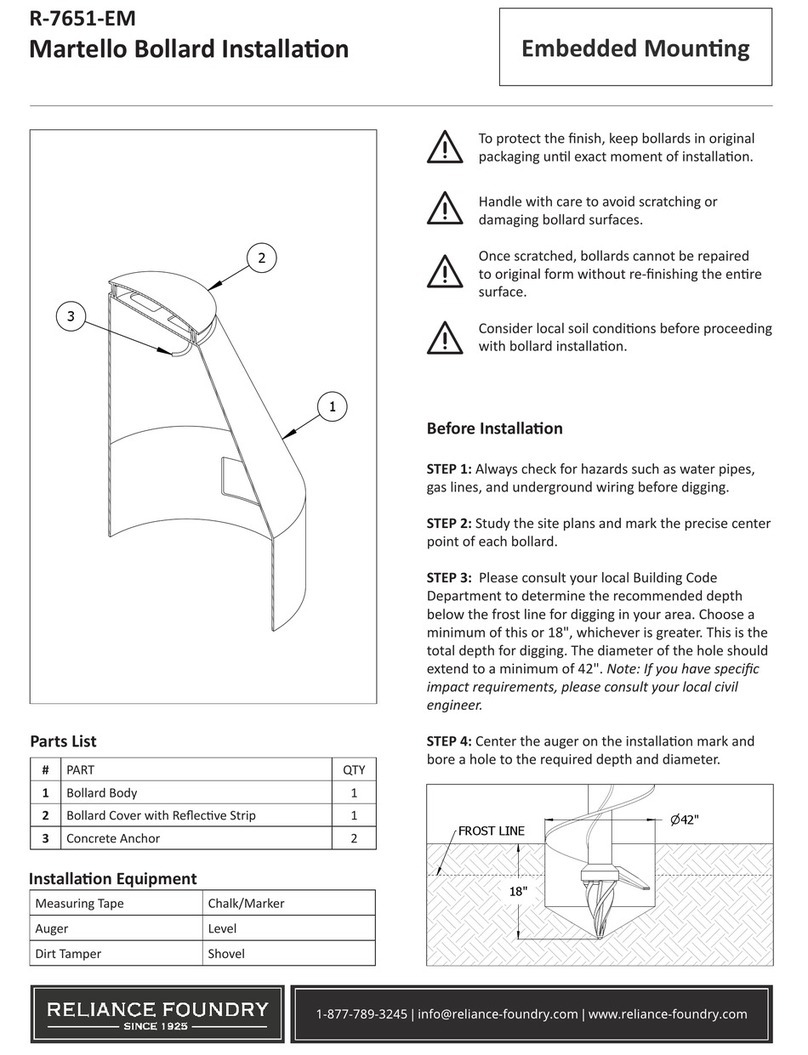
Reliance Foundry
Reliance Foundry R-7651-EM Installation

Norac
Norac UC4+ installation manual
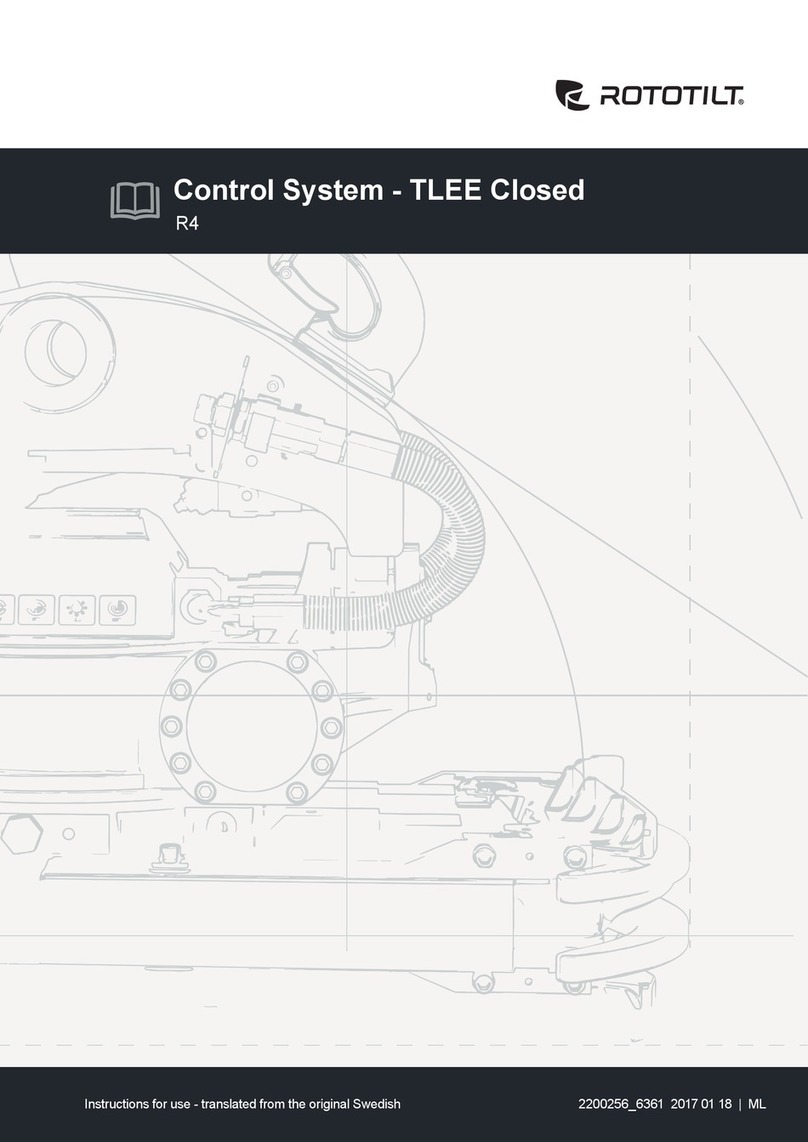
ROTOTILT
ROTOTILT TLEE Instructions for use
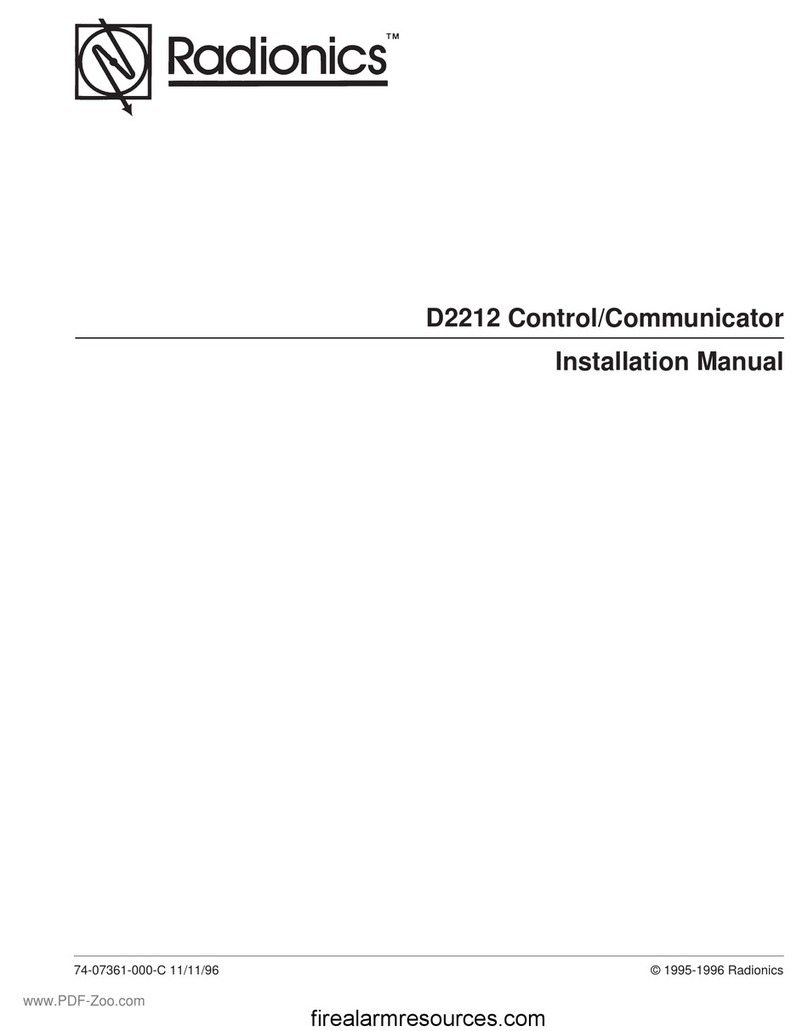
Radionics
Radionics D2212 installation manual
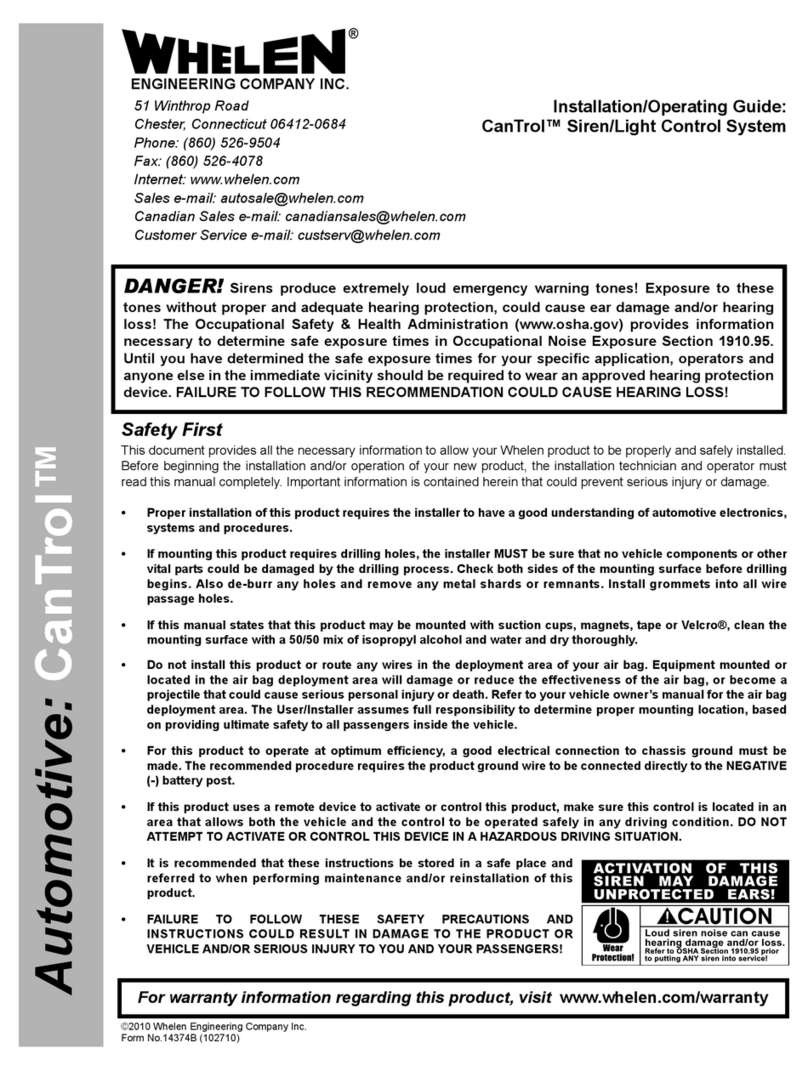
Whelen Engineering Company
Whelen Engineering Company CanTrol Installation & operating guide
